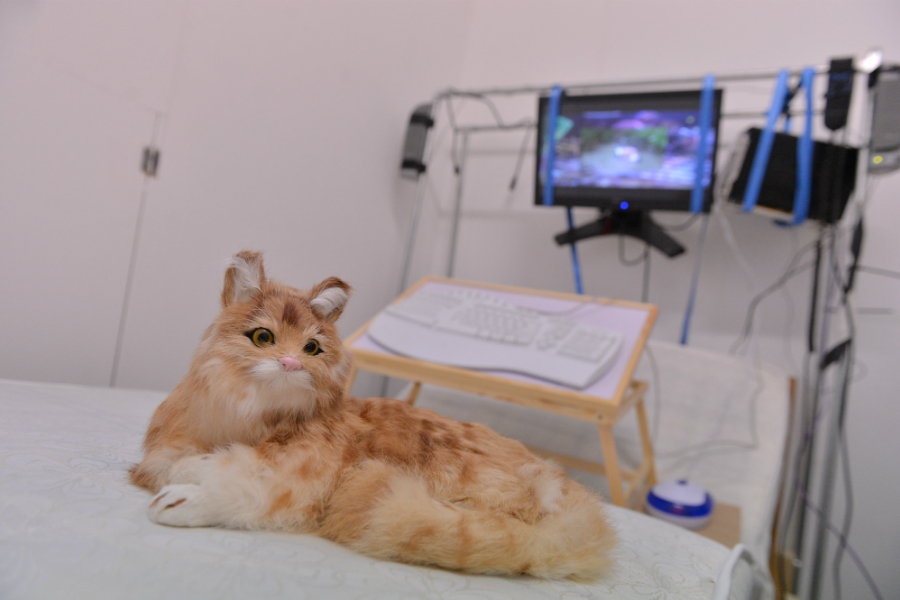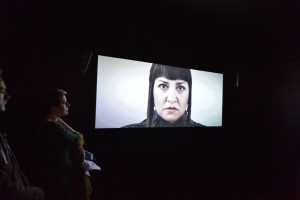Science Fiction: New Death — Reviewed

Self-confessed sci-fi nerd C James Fagan enters FACT’s new exhibition with high expectations, and leaves feeling somewhat deflated…
This is going to be hard. Sometimes when the subject matter is close to your heart, your expectations are raised, and there is often a tendency to be overtly critical. An example would be the fan reaction to The Phantom Menace.
Right now, FACT are offering a combination of two major forces in my life — science fiction and contemporary art — in their Science Fiction: New Death exhibition.
This could go either way, so fingers crossed and insert your own relevant sci-fi cliché here.
Passing through Gallery 1’s gateway entrance, all dressed up like a 80’s tv-show set, complete with flashing and bleeping, I walk into a facsimile of a space station. Through a window, I see banks of draws, wooden and inert. Through another door I find myself in a rather shabby-looking room; an ill-constructed apparatus straddles a bed, a plasma screen displays corrupted images, and there’s a stuffed cat.
In this space, there’s another space. A tiny den where a computer spews up clips that seemed to be dragged from the internet. All-girl mosh-pits, bondage furries. This is Jon Rafman’s installation, Hope Springs Eternal, a piece about the alienation brought about through being constantly wired to the infocloud. As I flip through the collection of DVD’s stacked on a nearby shelf, I do feel alienated and slightly disinterested in the detritus that surrounds me.
Into another space, where I find a projection waiting for me. This is Larissa Sansour’s nicely realised Nation Estate. Playing on the sci-fi trope of the mega-city, it imagines a solution to the Palestine problem whereby the entire population retreates into a huge, self-contained building. A solution which itself is problematic. It’s handsomely mounted; it feels like a trailer an introduction to a wider world expanding beyond the film’s 9 minutes.
Through the mini-maze of grey doors and walls there is another room, a brilliant yellow room. In this sea of egg yolk there is Ryan Trecartin’s Tommy Chat Just E-Mailed Me. Trecartin’s world is populated by obnoxious yet familiar characters who chatter and squeal, in a world constructed by a bored 12 year old editing YouTube videos. Of course, Trecartin’s work touches on how mass-communication effects human interactions.

By turns horrifying and funny, it presents a speculative present showing the impact three letters (www) have had on the human psyche. It shows us a possible outcome of the first internet generation.
In-between these works is Karen Mirza & Brad Butler’s Deep State, a film about time travellers, or ‘riotnauts’, visiting historical states of dissent. It’s another classic sci-fi trope, the time-tourist. I can only take in a small amount of the film, therefore don’t engage with the narrative, don’t make the connection between it and the poster of Thatcher and the takeaway flyers. Is this all evidence of the existence of time-travellers? If so, why are they interested in dissent?
I really want to write on the wall: John Titor was here!
Carrying on upstairs into Gallery 2, I encounter a piece by Zach Blas about the development of a mask which promises to disrupt facial recognition programmes (not unlike the ‘scramble suits’ in Philip K. Dick’s A Scanner Darkly). Two finished masks hanging on the wall make for interesting sculptural forms. It also makes a companion piece to Laurence Payot’s 1 in a Million You, which through the use of social networks attempts to create a new society. Members of this group adorn their faces with a special pattern. It makes for a strange paradoxical world where mass conformity equals freedom.
Around the corner from the masks, there is Mark Leckey’s Pearl Vision, following his interest in real and unreal spaces. It’s all very glossy; maybe it’s this high level of sheen which creates a barrier. I don’t really engage with the piece. Nearby there is Jae Rhim Lee’s Infinity Burial Project, or proposal for dealing with the bodies of the dead. To be honest, it’s hard to tell whilst looking at a fabric mannequin hanging there, not telling me much, nor does the image of a figure emerging from an Apollo capsule.
Elsewhere on the second floor is another glossy, polished film, The Heart of Perspective by Dario Solman. It presents a Powers of Ten-style camera/viewer journey through a huge empty city, a spaceship eventually leading to the cosmos which turns out to be inside a stylised human form. As the camera passes through, there is a slight sense of giddiness.
All the time there has been a desperate thumping; this is being created by a robot, a robot trapped behind a wall (Petra Gemeinboeck and Rob Saunders’ Accomplice). This robot is programmed to be bored; it bangs away on the wall in an attempt to get out, to be with you. Here is the horror of needy technology; of the technology that mirrors all the dodgy affectations we have as a race. There’s a sense of the uncanny to this, something close to what we call human.
Returning downstairs to the foyer, there are more pieces. A hologram spouting disinformation (James Bridle’s Homo Sacer), the relocation of Tarkovsky’s Stalker to a Wirral wasteland entitled The Zone (more on that soon?) and a trampoline which recreates zero-g experiments (Sascha Pohflepp’s Camera Futura).
At the entrance there is a collection of books, film and TV shows from the Science Fiction Foundation Collective. Here are a selection of editions ranging from the fifties to the present day; sometimes the same book with different covers, offering a display of society’s changing attitudes and taste in SF and beyond. They are kept behind a screen, which on getting closer obfuscates the images on the book covers, as if the possible narratives contained within these books are and always will be unattainable.
Ultimately, what did I think of this exhibition? As I visitor I felt oddly unengaged, empty even. I can only put this down to what feels like the absence of an individual narrative, a sense of the human (mostly evidenced in this show through Ryan Trecartin’s video and Petra Gemeinboeck & Rob Sander’s robots). It might also lay in the curator — Omar Kholeif’s — use of the objective ‘Ballardian’; having over the last 15 years devoured the majority of J.G. Ballard’s texts, I have come to see this term to mean or represent a singular transformative experience or journey.
Many of Ballard’s heroes are faced with a contemporary realm, a speculative present where the technology of that world effects humanity’s collective psyche. The Ballardian hero comes to embrace this change, understanding that this is connected to an inner evolution. This provides Ballard’s work with a strange optimism that the technology we create is there to impart this change — it’s a positive thing.
Though the exhibition is interesting and amazingly ambitious in the way it attempts to engage the viewer in a specific world, I felt that I never fully engaged with the work within the framework of a ‘speculative present’. Maybe the exhibition needs repeat viewings, and like the good sci-fi nerd I am, I will return.
C James Fagan
Science Fiction: New Death continues at FACT Liverpool until 22 June 2014, free entry
Read C James Fagan’s essay on Ballard’s Concrete Island





